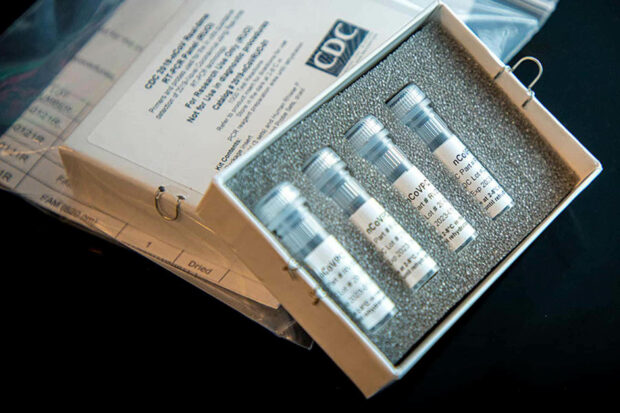May 2020 COVID-19 Update: Passing the Test?
The COVID-19 pandemic metrics suggest that Missouri and Kansas are emerging from the worst of the crisis. Will those trend lines hold as economic restrictions are lifted?
By Dennis Boone

The good news, to people starving for some amid the carnage of the COVID-19 pandemic, is that in this region, the caseloads appear to be tapering off. A number of metrics reinforce that:
- The Web site rt.live, created by a pair of Instagram co-founders, showed that as the second week of May began, the spread of transmission in Kansas had just fallen below a key threshold, signaling that the spread was on the verge of declining. Missouri saw its corresponding case fall below growth levels two weeks earlier.
- Moving seven-day averages for both case counts and death tolls for Missouri and Kansas continue to drop, as reported by their respective health departments.
- On a more micro level, the number of returning tests confirming the presence of COVID-19 in Johnson County continues to fall, even as more people undergo the procedures. As the county’s testing rate inched up to 15.7 per 1,000 residents, the confirmed presence of COVID-19 infections fell to 6.3 percent of those tested. Given the numbers of people who haven’t been tested and who have shown no symptoms of the illness, the overall infection and death rates could be considerably lower than first feared when the outbreak exploded across the nation in mid-March.
- The number of patients admitted to the University of Kansas Medical Center fell to its lowest level in more than a month as of May 18. The 15 being treated there represented less than half the caseload from a month earlier.
- And on a macro level, nationwide fatalities, reported by each state and aggregated on the Web site worldometers.com, showed a sharp drop in daily deaths, below 2,000 each day for May 8 and 9. The true significance of that will be revealed as numbers come in over the rest of the month, but it tracks with broader measures of 7-day averages showing a consistent decline since the death toll peaked in late April.
- Perhaps most uplifting of all, if one can find relief sifting through stacks of charts about death and sickness, is that on May 11, the nationwide toll of new deaths nearly fell below 1,000. At 1,008, it was the lowest level since March 28, a time when the pandemic was just beginning to realize its potential lethality.
Health officials in the two-state region will be paying careful attention to the new-case numbers starting this week, to see if they suggest that a loosening of restrictions on economic activity will result in the dreaded “second wave’ of infections that many have predicted.
Their efforts remain hampered by a lack of sufficient testing resources—kits, growth media, labs—to assess broader population trends. Unable to see the true extent of the viral presence in the overall population, elected leaders have implemented policies to restrict business activity without information vital to a rigorous cost-benefit analysis of the self-imposed recession.
As a result of those slowdowns, more than 350,00 Kansas filed first-time unemployment claims in the final two weeks of April, and more than half a million Missourians did the same, according to the U.S. Department of Labor. All told the economy has seen an unprecedented 20.5 million jobs vanish since the crisis began, driving a once-thriving unemployment rate from 3.5 percent to 14.7 percent.
Against that backdrop, business leaders are looking for a path to recovery as each state lays out plans to ease restrictions on social and economic activity.
In Kansas. Gov. Laura Kelly released a four-phase plan called the Kansas Essential Function Framework, setting out a month-long series of steps to loosen the vise:
- Through May 18, and subject to revision in the event of a renewed outbreak, gatherings of more than 10 people are prohibited, such as swimming pools, sports facilities and summer camps. Among the businesses that could face penalties for operating are bars and nightclubs (excluding those already using curbside and carryout services), non-tribal casinos, indoor leisure spaces (movie theaters, fitness centers, gyms, etc.), and personal services such as barber shops and beauty salons.
- Between May 18 and June 1, the head-count on previously restricted venues rises from 10 to 30, and bars or restaurants are authorized to operate at 50 percent of seating capacity. Pools, community centers and most sports activities would be allowed to resume operations.
- As of June 1, workplace staffing restrictions would be lifted, the cap on mass gatherings would rise from 30 to 90, and travel restrictions would end. Restaurants and bars would be able to open without facing penalties.
- And effective June 15, the state would have in place only its recommendations for behaviors to help control spread of a contagion: maintaining social distancing, staying home if sick and adhering to personal hygiene recommendations on hand-washing and covering coughs or sneezes.
Missouri, by contrast, relies more heavily on individual responsibility to maintain safe practices, but though May 31 does offer restrictions on nursing-home visitation and religious gatherings, the latter subject to social-distancing provisions.
As for retail and entertainment businesses, Gov. Mike Parson’s executive order limits to 25 percent of a building’s authorized capacity the number of people allowed inside at facilities of less than 10,000 square feet, and 10 percent of authorized capacity at larger venues.
